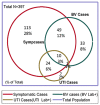Menstrual Hygiene Practices, WASH Access and the Risk of Urogenital Infection in Women from Odisha, India
- PMID: 26125184
- PMCID: PMC4488331
- DOI: 10.1371/journal.pone.0130777
Menstrual Hygiene Practices, WASH Access and the Risk of Urogenital Infection in Women from Odisha, India
Abstract
Menstrual hygiene management (MHM) practices vary worldwide and depend on the individual's socioeconomic status, personal preferences, local traditions and beliefs, and access to water and sanitation resources. MHM practices can be particularly unhygienic and inconvenient for girls and women in poorer settings. Little is known about whether unhygienic MHM practices increase a woman's exposure to urogenital infections, such as bacterial vaginosis (BV) and urinary tract infection (UTI). This study aimed to determine the association of MHM practices with urogenital infections, controlling for environmental drivers. A hospital-based case-control study was conducted on 486 women at Odisha, India. Cases and controls were recruited using a syndromic approach. Vaginal swabs were collected from all the participants and tested for BV status using Amsel's criteria. Urine samples were cultured to assess UTI status. Socioeconomic status, clinical symptoms and reproductive history, and MHM and water and sanitation practices were obtained by standardised questionnaire. A total of 486 women were recruited to the study, 228 symptomatic cases and 258 asymptomatic controls. Women who used reusable absorbent pads were more likely to have symptoms of urogenital infection (AdjOR=2.3, 95%CI1.5-3.4) or to be diagnosed with at least one urogenital infection (BV or UTI) (AdjOR=2.8, 95%CI1.7-4.5), than women using disposable pads. Increased wealth and space for personal hygiene in the household were protective for BV (AdjOR=0.5, 95%CI0.3-0.9 and AdjOR=0.6, 95%CI0.3-0.9 respectively). Lower education of the participants was the only factor associated with UTI after adjusting for all the confounders (AdjOR=3.1, 95%CI1.2-7.9). Interventions that ensure women have access to private facilities with water for MHM and that educate women about safer, low-cost MHM materials could reduce urogenital disease among women. Further studies of the effects of specific practices for managing hygienically reusable pads and studies to explore other pathogenic reproductive tract infections are needed.
Conflict of interest statement
Figures
References
-
- Adinma ED, Adinma JI (2008) Perceptions and practices on menstruation amongst Nigerian secondary school girls. Afr J Reprod Health 12: 74–83. - PubMed
-
- Narayan K, Srinivasa D, Pelto P, Veerammal S (2001) Puberty rituals reproductive knowledge and health of adolescent schoolgirls in south India. Asia-Pacific Population Journal 16: 225–238.
Publication types
MeSH terms
Grants and funding
LinkOut - more resources
Full Text Sources
Other Literature Sources
Medical



